Inside The New York Botanical Garden
Esther Jackson
Posted in From the Library on November 21 2016, by Esther Jackson
Esther Jackson is the Public Services Librarian at NYBG’s LuEsther T. Mertz Library where she manages Reference and Circulation services and oversees the Plant Information Office. She spends much of her time assisting researchers, providing instruction related to library resources, and collaborating with NYBG staff on various projects related to Garden initiatives and events.
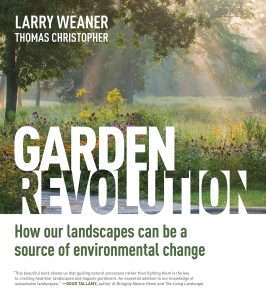 Timber Press has really been hitting the mark over the past few years with books related to landscape design, land management, and ecology. Planting in a Post Wild World, read as a landscape design manifesto, was my favorite recent book of this ilk, and Cultivating Chaos offered some truly breathtaking examples of “wild” plantings and garden design.
Timber Press has really been hitting the mark over the past few years with books related to landscape design, land management, and ecology. Planting in a Post Wild World, read as a landscape design manifesto, was my favorite recent book of this ilk, and Cultivating Chaos offered some truly breathtaking examples of “wild” plantings and garden design.
When I opened Garden Revolution, I expected a book like Post Wild World or Cultivating Chaos. In fact, Revolution looks at the same big questions of land management and ecology, but leads the reader on a rather different journey.
Read More
Posted in From the Library on November 14 2016, by Esther Jackson
Esther Jackson is the Public Services Librarian at NYBG’s LuEsther T. Mertz Library where she manages Reference and Circulation services and oversees the Plant Information Office. She spends much of her time assisting researchers, providing instruction related to library resources, and collaborating with NYBG staff on various projects related to Garden initiatives and events.
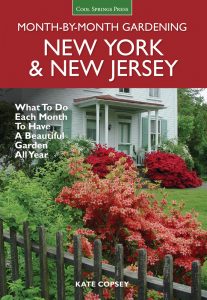 The seasonal chores related to gardening can be both a comfort and a pressure for the horticulturally inclined. This selection of recent books details various seasonal aspects of gardening, including the weather, nature journaling, and monthly chores to tackle in our area.
The seasonal chores related to gardening can be both a comfort and a pressure for the horticulturally inclined. This selection of recent books details various seasonal aspects of gardening, including the weather, nature journaling, and monthly chores to tackle in our area.
For the practical-minded, there is New York & New Jersey Month-by-Month Gardening by Kate Copsey. Do you feel like you might be forgetting a November chore? Copsey’s book shares guidance with home gardeners who love to-do lists and careful seasonal planning. New York & New Jersey Getting Started Garden Guide by Vincent Simeone is another title that can be used in tandem with Copsey’s recent publication.
Moving from to-do lists to more academic pursuits, next comes the topic of nature journaling with Flora Forager: A Seasonal Journal Collected from Nature by Bridget Beth Collins. I first came across Collins’s work through her Instagram account, where you can see her use of leaves, petals, and other natural materials to create beautiful scenes, landscapes, and animal portraits. Located in the Pacific Northwest, Collins uses materials from her garden and forages from “urban wild areas” in her neighborhood. The journal is laid out into four seasons, each one featuring a unique, full-page collage. Empty, lined pages are adorned with smaller floral pieces that repeat throughout the work. Regular visitors to the NYBG Shop might recall the notecards Collins produced with the Garden last year, now available through Collins’s website.
Read More
Posted in From the Library on November 7 2016, by Esther Jackson
Esther Jackson is the Public Services Librarian at NYBG’s LuEsther T. Mertz Library where she manages Reference and Circulation services and oversees the Plant Information Office. She spends much of her time assisting researchers, providing instruction related to library resources, and collaborating with NYBG staff on various projects related to Garden initiatives and events.
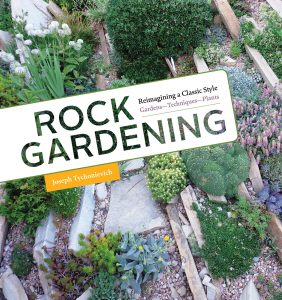 Rock Gardening: Reimagining a Classic Style is the newest book from Joseph Tychonievich, published with Timber Press. Tychonievich has previously authored Plant Breeding for the Home Gardener: How to Create Unique Vegetables and Flowers and The Complete Guide to Gardeners: The Plant Obsessed and How to Deal With Them. Organic Gardening Magazine has called him one of “six young horticulturists who are helping to shape how America gardens,” and those who move in the horticulture social media world may recognize his charming and relatable comics about plant geeks.
Rock Gardening: Reimagining a Classic Style is the newest book from Joseph Tychonievich, published with Timber Press. Tychonievich has previously authored Plant Breeding for the Home Gardener: How to Create Unique Vegetables and Flowers and The Complete Guide to Gardeners: The Plant Obsessed and How to Deal With Them. Organic Gardening Magazine has called him one of “six young horticulturists who are helping to shape how America gardens,” and those who move in the horticulture social media world may recognize his charming and relatable comics about plant geeks.
Rock gardening is back in vogue, according to this new book. For those who live in the greater NYC and Westchester regions, it may never have left entirely. Because of the rocky terrain that our region boasts, “The art of growing alpines and other miniature plants in the company of rocks to recreate the look of rugged mountaintops” is a savvy and beautiful use of space. Beyond beauty, an additional utility can be found in creating drought-tolerant plantings for water-wise gardens. Rock gardens have the potential to be sustainable and low-maintenance while still providing great color and texture. For gardeners looking for an introduction to rock gardening, Tychonievich’s book is a great start.
Read More
Posted in From the Library on October 31 2016, by Esther Jackson
Esther Jackson is the Public Services Librarian at NYBG’s LuEsther T. Mertz Library where she manages Reference and Circulation services and oversees the Plant Information Office. She spends much of her time assisting researchers, providing instruction related to library resources, and collaborating with NYBG staff on various projects related to Garden initiatives and events.
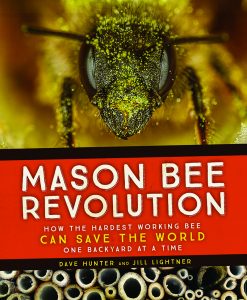 For gardeners curious about mason bees or building pollinator havens in general, Mason Bee Revolution is a lovely new book from Dave Hunter and Jill Lightner. The passion that the authors have for the topic at hand is infectious. Why keep mason bees? Compared to honey bees, it turns out that these pollinators are lower-maintenance, cheaper, and will pollinate more plants per insect than honey bees. They are also docile and child-friendly.
For gardeners curious about mason bees or building pollinator havens in general, Mason Bee Revolution is a lovely new book from Dave Hunter and Jill Lightner. The passion that the authors have for the topic at hand is infectious. Why keep mason bees? Compared to honey bees, it turns out that these pollinators are lower-maintenance, cheaper, and will pollinate more plants per insect than honey bees. They are also docile and child-friendly.
This book is filled with small projects, practical how-to information, and suggested resources from the home beekeeper. The real strength of this book is the practical, easy-to-follow instructions about setting up nesting sites and habitat for mason bees and leafcutter bees. Materials, site requirements, harvesting cocoons, and over-winter storage are all topics that the authors address. There is a lot of information, but it is easy to follow. Although the book is 154 pages there are points when the narrative meanders slightly, and there is occasional repetition.
Read More
Posted in From the Library, Shop/Book Reviews on October 24 2016, by Esther Jackson
Esther Jackson is the Public Services Librarian at NYBG’s LuEsther T. Mertz Library where she manages Reference and Circulation services and oversees the Plant Information Office. She spends much of her time assisting researchers, providing instruction related to library resources, and collaborating with NYBG staff on various projects related to Garden initiatives and events.
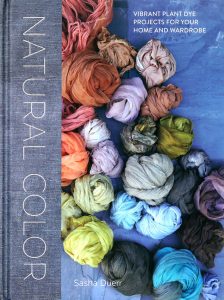 Natural Color: Vibrant Plant Dye Projects for Your Home and Wardrobe has the look of a book that is waiting to be touched. With its slightly-textured cover materials and luscious cover photo it draws the eye while subtlety hinting at the projects it contains. This book by Sasha Duerr, published with Ten Speed Press, builds in part off of her earlier publication The Handbook of Natural Plant Dyes which was published in 2010 with Timber Press.
Natural Color: Vibrant Plant Dye Projects for Your Home and Wardrobe has the look of a book that is waiting to be touched. With its slightly-textured cover materials and luscious cover photo it draws the eye while subtlety hinting at the projects it contains. This book by Sasha Duerr, published with Ten Speed Press, builds in part off of her earlier publication The Handbook of Natural Plant Dyes which was published in 2010 with Timber Press.
Natural Color opens with a gorgeous image of a passionflower (Passiflora edulis) photographed by Aya Bracket. Bracket’s photos coupled with precise and artistic page layouts make this book about practical handicraft a work of art in and of itself. Even those who have not dyed materials (and perhaps have no real desire to do so) can appreciate the beauty of this work. Duerr’s couching of her dyeing ethics within permaculture is both intriguing and accessible. One of the names associated with “slow fashion,” Duerr champions both self-sufficiency for people as well as respect for and harmony with the natural world. Many of the projects in Natural Color make use of cultivated garden plants, non-native plants that have become “weeds,” and plants that can be sustainably and responsibly harvested.
Read More
Posted in From the Library on October 17 2016, by Esther Jackson
Esther Jackson is the Public Services Librarian at NYBG’s LuEsther T. Mertz Library where she manages Reference and Circulation services and oversees the Plant Information Office. She spends much of her time assisting researchers, providing instruction related to library resources, and collaborating with NYBG staff on various projects related to Garden initiatives and events.
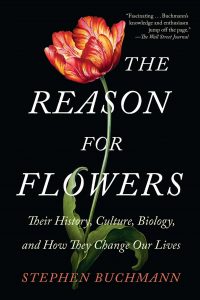 The Reason for Flowers is the most recent book from pollination ecologist and entomologist Stephen Buchmann. Buchmann’s primary research is focused on pollinators, and several of his earlier books are specifically about bees.
The Reason for Flowers is the most recent book from pollination ecologist and entomologist Stephen Buchmann. Buchmann’s primary research is focused on pollinators, and several of his earlier books are specifically about bees.
Flowers, as Buchmann writes, are an integral part of human history. Flowers (or plants, more generally) are cultivated, harvested, killed, eaten, admired, and imbued with a myriad of symbols. On top of human interactions with flowers, there are also pollinator interactions with flowers. In short, the scope of this book is enormous. Fourteen chapters in five sections cover topics from flower fossils to flowers in contemporary science. In between are sections detailing popular flowers in historic gardens from around the world, edible flowers, flowers in art and literature, and “healing” flowers.
Read More
Posted in From the Library on October 3 2016, by Esther Jackson
Esther Jackson is the Public Services Librarian at NYBG’s LuEsther T. Mertz Library where she manages Reference and Circulation services and oversees the Plant Information Office. She spends much of her time assisting researchers, providing instruction related to library resources, and collaborating with NYBG staff on various projects related to Garden initiatives and events.
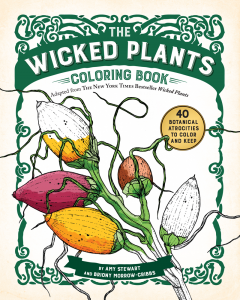 Amy Stewart delighted readers with her 2009 book Wicked Plants from Algonquin Books. With a scope that included poisonous plants, plants that cause physical injuries, invasive plants, and addictive plants, Stewart engaged and alarmed her audience with cautionary tales about, and cultural histories of, some of the plant kingdom’s more dangerous and infamous members. Now, in 2016, The Wicked Plants Coloring Book renews the theme, highlighting some of the wickedest and most beautiful plants.
Amy Stewart delighted readers with her 2009 book Wicked Plants from Algonquin Books. With a scope that included poisonous plants, plants that cause physical injuries, invasive plants, and addictive plants, Stewart engaged and alarmed her audience with cautionary tales about, and cultural histories of, some of the plant kingdom’s more dangerous and infamous members. Now, in 2016, The Wicked Plants Coloring Book renews the theme, highlighting some of the wickedest and most beautiful plants.
One of the things that made Wicked Plants so engaging was the care taken by Stewart to use Latin names (binomials) for the organisms she discussed. Stewart also situated each species within a larger context. Readers would learn the properties of a plant like Mandragora officinarum (mandrake) and then in turn learn about its relatives. In the case of M. officinarum, “the notorious nightshade family includes peppers, tomatoes, and potatoes, along with deadly nightshade and belladonna.” This context was helpful to readers who did not have botanical or horticultural backgrounds and made phylogeny, or the study of relationships, accessible to the average reader.
Read More
Posted in From the Library on September 26 2016, by Esther Jackson
Esther Jackson is the Public Services Librarian at NYBG’s LuEsther T. Mertz Library where she manages Reference and Circulation services and oversees the Plant Information Office. She spends much of her time assisting researchers, providing instruction related to library resources, and collaborating with NYBG staff on various projects related to Garden initiatives and events.
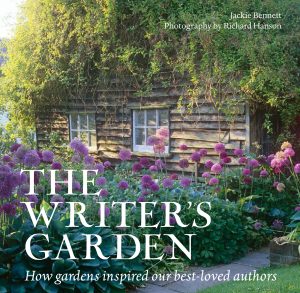 The Writer’s Garden: How gardens inspired our best-loved authors drew my eye even before I realized that this new book is from Jackie Bennett, the author of 2016’s Shakespeare’s Gardens (which I reviewed here). Once I realized the authors were one and the same, I knew I was in for a treat.
The Writer’s Garden: How gardens inspired our best-loved authors drew my eye even before I realized that this new book is from Jackie Bennett, the author of 2016’s Shakespeare’s Gardens (which I reviewed here). Once I realized the authors were one and the same, I knew I was in for a treat.
With photographs by Richard Hanson, Writer’s Garden is a very thoughtful and lovely book. Bennett explores the gardens and estates of 19 authors in the United Kingdom. The authors themselves—English, Irish, Scottish, or American by birth—left their marks in the form of their gardens on the British landscape. Bennett is an engaging tour-guide through the landscapes that shaped their works, inspired their art, and became their homes. Using an individual’s garden as a way of telling his or her story is indeed a popular device. At The New York Botanical Garden, there have been several garden-wide exhibitions around this theme. Most recently, FRIDA KAHLO: Art, Garden, Life in 2015, which followed Monet’s Garden of 2012, Emily Dickinson’s Garden: The Poetry of Flowers of 2010, and Darwin’s Garden: An Evolutionary Adventure of 2009.
Read More
Posted in From the Library on September 19 2016, by Esther Jackson
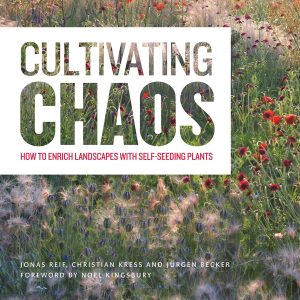 Organized chaos has its charms, as the authors of Cultivating Chaos: How to Enrich Landscapes with Self-Seeding Plants are eager to extol. There is both an anxiety and a freedom that comes with allowing garden plants to live out their life cycles unmolested—setting seeds and dropping them from cradle to grave and back again. In Chaos’s introduction, Noel Kingsbury writes of using self-seeding plants to establish and encourage a more full and vibrant ecological system in the garden. In the pages that follow, the authors take up this idea and expand upon the theme.
Organized chaos has its charms, as the authors of Cultivating Chaos: How to Enrich Landscapes with Self-Seeding Plants are eager to extol. There is both an anxiety and a freedom that comes with allowing garden plants to live out their life cycles unmolested—setting seeds and dropping them from cradle to grave and back again. In Chaos’s introduction, Noel Kingsbury writes of using self-seeding plants to establish and encourage a more full and vibrant ecological system in the garden. In the pages that follow, the authors take up this idea and expand upon the theme.
Part of embracing “chaos” in the garden requires letting go. When planting communities that are intended to be self-seeding, the gardener should, in theory, release some control. There might be a plan in mind, but there should also be a willingness to see what the plants do when left to their own devices. The gardener might only work to remove undesirable plants and to fill in gaps when different species die off.
Chaos has a great deal of practical advice for the home gardener. The book is divided into four sections, plus a resources section. “How do you garden with self-seeding plants?,” “Let the planting begin,” “Strategies for design and maintenance,” and “Plants for self-seeding gardens” take the home gardener through the process of using self-seeding plants from start to finish. Gorgeous photographs of different gardens adorn the book’s pages throughout the narrative.
Read More
Posted in From the Library on September 12 2016, by Esther Jackson
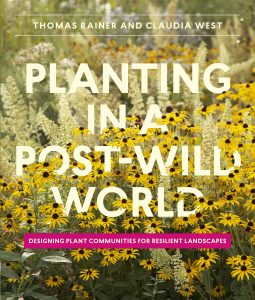 Sometimes one comes across a landscape design book that simply demands to be read from cover to cover without pause. Planting in a Post-Wild World is one such book. Part ecological manifesto, part how-to planting guide, and part artistic statement, Post-Wild is a wonderful and refreshing addition to the world of landscape and planting design literature.
Sometimes one comes across a landscape design book that simply demands to be read from cover to cover without pause. Planting in a Post-Wild World is one such book. Part ecological manifesto, part how-to planting guide, and part artistic statement, Post-Wild is a wonderful and refreshing addition to the world of landscape and planting design literature.
Thomas Rainer and Claudia West are co-authors of Post-Wild. Rainer is a registered landscape architect, teacher, and writer, and West is a landscape designer, lecturer, and consultant. Both work in the U.S., but in the evocative preface each writes of the very different beginnings of their understanding of the wild.
Read More
 Timber Press has really been hitting the mark over the past few years with books related to landscape design, land management, and ecology. Planting in a Post Wild World, read as a landscape design manifesto, was my favorite recent book of this ilk, and Cultivating Chaos offered some truly breathtaking examples of “wild” plantings and garden design.
Timber Press has really been hitting the mark over the past few years with books related to landscape design, land management, and ecology. Planting in a Post Wild World, read as a landscape design manifesto, was my favorite recent book of this ilk, and Cultivating Chaos offered some truly breathtaking examples of “wild” plantings and garden design.








